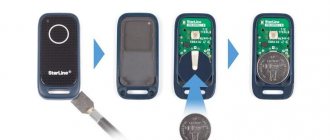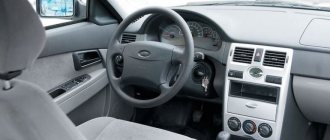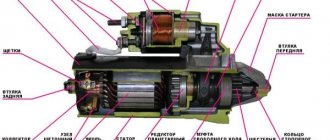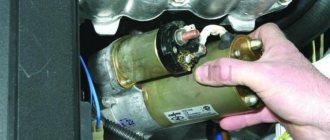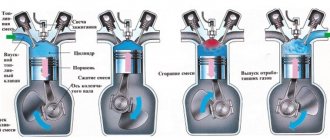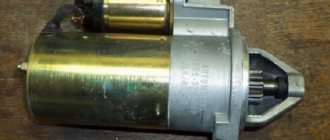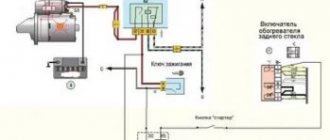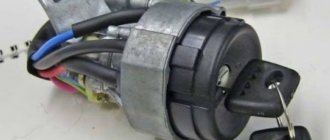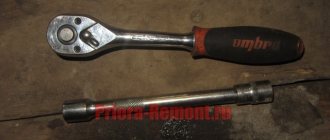It is a very sad situation when the VAZ 21099 injector does not start. Domestic cars are not famous for their reliability, therefore, you need to be able to find the cause of the breakdown and eliminate it if you own a VAZ. On this page we will tell you why the nine may not start and how to fix the main problems in a garage environment. Particular attention will be paid to the injection system, because understanding it is much more difficult than understanding that the starter does not turn.
The VAZ 21099 injector does not start for several reasons, there are not many of them, it will be possible to consider everything in detail. The good thing is that the injection system on this model is the simplest, so repairs and troubleshooting will not be difficult. It is important to know which elements are responsible for starting the engine and look for problems with them.
Problems with sensors
In order for the injection engine to start, the electronic control unit (ECU) must receive signals from almost all sensors that are under the hood. If one of the main sensors fails, the engine will not start. It is worth saying that most often the problem lies in the sensors.
Sensors that are involved in starting the engine:
- Crankshaft sensor;
- Temperature sensor;
- Mass air flow sensor (MAF);
- Idle air control (IAC);
- Throttle sensor.
In principle, the engine can start and run even without several sensors, however, if the crankshaft sensor fails, then the engine will not be able to start. Symptoms of a non-working crankshaft sensor are as follows: the starter turns and no changes occur, the engine does not “catch” even when the gas pedal is pressed. If with such symptoms you are sure that everything else is in order, you need to inspect the wiring of the DC; at the place where the connector is connected, the wires often break off. When the wires are intact, we can conclude that the DC is faulty. We buy a new recreation center and put it in place.
If the engine somehow “cages”, but does not start normally, it feels like two or three cylinders are working, then we look for the reason in other sensors. The first step is to remove the chip from the mass air flow sensor, because there is a possibility that this sensor gives incorrect readings on the amount of air and the ECU calculates the incorrect amount of gasoline. If this is the reason, then when the chip is removed from this sensor, the engine will start normally and will maintain increased speed at idle, this will mean operation in emergency mode.
In the case where removing the chip from the mass air flow sensor did not change the situation in any way, the engine continues to seize a little, we continue to look for the problem. While the starter is rotating, you can try pressing the gas pedal. With a high probability, the engine will start, and if you don’t give it more gas, it will immediately stall. This situation tells us that one of the sensors is faulty, except for the crankshaft sensor; if it breaks down, as we already understand, the engine cannot be started.
The easiest way is to find a person with a fuel-injected 8-valve engine that works properly, and install the sensors one at a time from his car onto yours. In this way, it is worth checking only three sensors: the temperature sensor (which is in the thermostat housing), the throttle sensor and the idle speed control. When the “culprit” is found, you need to buy the same sensor and replace it.
Voltage problems
With the onset of cold weather, worn-out batteries make themselves felt. If on carburetor cars the sign of a dead battery is a weakly rotating starter or not rotating the crankshaft at all, then with an injector the situation is somewhat different. In a situation where the battery is not sufficiently charged, on an injection VAZ, when you turn the key, only relay clicks will be heard, and the dashboard lights will blink. This is the picture that scares many owners of this model, because they think that the problem lies somewhere in the “electrics”. So, if your car does not start with such symptoms, then you need to change the battery. But, if the battery is quite fresh, and at this time cannot become unusable, then the problem lies in its weak charging.
It often happens that the generator does not provide the required charge, but only produces 12.5-13 volts. If in the summer this was enough to slightly charge the battery and start the engine, then in cold weather such an “undercharged” battery will no longer crank the starter. If your car, with consumers turned off, is charging less than 13 volts, then you need to solve this problem. Possible causes include: insufficient alternator belt tension, faulty voltage regulator, worn brushes and worn slip rings. Reasons to check in this order.
Other Possible Problems
Finally, here is a list of problems that can also cause the engine to start. If everything is in order with the sensors and the battery is normal, then you should pay attention to this list. Let's start with the more common problems and end with the rather rare ones. Possible problems with the engine not starting:
- The starter relay has failed. To check, you need to put your hand towards it, and at this time the assistant tries to start it. A click should be felt; if it is not there, the relay needs to be replaced;
- The timing belt has jumped. If the car is , it is possible that the timing belt has jumped one or more teeth. It could still slip due to the fact that the belt was not tensioned enough and was badly worn;
- The fuel pump has failed. There is only one symptom: when you turn on the ignition, you can’t hear it working;
- Problems with the ignition module. The module has two windings, if one is burned out, then a spark will not be supplied to a pair of cylinders, if there are two, there will be no spark at all;
- Problems with the ECU and firmware. The electrical keys that are responsible for starting the engine could have burned out in the ECU, or the firmware could simply have been “lost”, and therefore the VAZ 21099 injector will not start. But, it is worth noting that you can look at the ECU as a last resort, because problems with it are extremely rare, unless there are power surges in the on-board network.
Often, owners of VAZ Nines are faced with a problem when the car is difficult to start when cold. It’s worth warning right away that there may be several reasons for this. Therefore, it is best to start your search with the simplest, gradually moving on to more complex ones.
Possible reasons why a VAZ-2109 car is difficult to start when cold
It should be immediately noted that when searching, you should definitely take into account what kind of engine you have. Of course, there are common reasons, but the search algorithm for an injection engine (16 valves) will be slightly different from a carburetor engine. The first option, as you know, was put on the “nine” of later issues. Most of the cars in this family were equipped with carburetor engines (8 valves).
As mentioned above, it is simply impossible to give an exact answer to the question why the car does not start well when cold. Generally speaking, the main reasons are as follows:
- weak battery charge;
- broken valve clearances;
- poor condition of the ignition coil, high-voltage wires, spark plugs;
- contamination of the throttle valve or fuel filter;
- air leaking past the carburetor;
- Idle air valve clogged.
It should also be noted that if you have an LPG system, then the car needs to be started on gasoline, not gas. A problem with the operation of the fuel pump cannot also be ruled out. The most common reason is a dead battery. It's very simple to check this - turn on the headlights and see how bright they shine. However, the sound of a rotating starter will indicate the problem. The latter, by the way, may not rotate at all. This means that the battery is very deeply discharged.
Now let's look at typical problems for a carburetor engine. One of them is the lack of fuel in the float chamber. Accordingly, it should be pumped up using the lever on the gas pump. Also try knocking on the carburetor, it is quite possible that the needle valve needle is stuck in the up position when the fuel supply is shut off. Check the spark plugs - if they are wet, the fuel mixture is too rich. The problem is solved by adjusting the carburetor. By the way, there may be such a reason as the mixture being too lean. In this case, you will also need to adjust the carburetor. You can check high-voltage wires in the dark. To do this, start the car, turn off the headlights and look under the hood. If there is a problem, you will see it immediately. Another option for checking is to borrow a kit that is known to work from someone.
Why the VAZ 2109 does not start - searching for the reason
The first step is to check the fuel, spark and air.
I would advise you to first check the air supply (compression and valve timing phases), you can also start with.
The marks on the pulleys may match, but the compression may fail a little, for example: on one cylinder 10 atm, on the second 9.5 atm, on the third 7 atm, and on the fourth 8 atm, this can only be corrected. Of course, it is worth getting serious about repairing the engine, but for now we need to put it off, since we will need to start the car. Having such compression, the engine will work and even not bad, but at idle it will be under pressure.
Checking the power system
Next, we begin to delve into the power system. You will need to make sure that the pump is properly supplying fuel to the required level, and that the idle air valve is operating without failure. Therefore, everything is in order with the fuel supply. Also, do not forget to check the spark plugs; after a couple of attempts to start the engine, they will probably flood.
Checking the ignition system
Since the previous failure options were not confirmed, then the problem needs to be looked for in the ignition system. To carry out a routine check, simple instruments are useful; they can be bought without any problems at any auto store. But first you need to understand the structure and operation of the ignition.
And so, in our case, the VAZ 2109 has a contactless ignition system. This system includes:
- reel,
- distributor,
- switch,
- Hall Sensor.
The coil is connected to the battery with one terminal, and the second to the output transistor of the switch. The switch opens the output transistor when the signal drops to zero. At this moment, a high voltage current of approximately 25 kV appears in the secondary winding of the coil, and a current of more than 300 V appears in the primary winding. As a result, a high voltage voltage appears on the spark plugs, resulting in a spark appearing on the plugs.
But for a discharge to occur, the coil must be charged. Before the control pulse from the Hall sensor, the switch predicts when it needs to be shorted to ground in order to charge it.
Moreover, he does this in such a way that the charging time of the coil remains approximately unchanged. Otherwise, the coil will overcharge. To do this, the switch calculates the required period of the pulses that come from the Hall sensor. In other words, everything depends on the engine speed, the higher the speed, earlier the commutator begins to close the coil, but the time of the closed state will not change.
Now you can start testing. First of all, you need to check the spark on the candles - you can use a special spark gap for this. There is no result.
This means the hall sensor or switch may be to blame, or ground or power to the switch. In order not to guess for a long time, we will use AZ-1.
AZ-1 is an emergency ignition; it can be used in the rain or when driving through puddles. In other words, we can call it a substitute for a hall sensor.
MD-1 sensor - instant diagnostics, useful for hall sensors and ignition switches.
First of all, we used MD-1. This sensor is connected instead of the switch, as soon as it is hooked up, you need to turn on the ignition, do not start it:
- If the “P” LED lights up, this means that the ignition relay and ignition switch are working properly.
- LED “K” is on - the primary winding of the ignition coil is not damaged.
- turn on the starter: if the LED “D” blinks, it means the Hall sensor is in working condition.
If it does not blink, you will have to use the AZ-1 device and connect it instead of the Hall sensor.
Such devices for instant diagnostics of non-contact ignition systems are sold on the Internet for literally 100 rubles. But if you do not have the opportunity to purchase one, then you will have to spend much more time and check each sensor separately with a multimeter.
Everything works, but the engine doesn’t want to start. After a thorough inspection of the ignition coil, carbon traces were found where the high-voltage wire was connected. Replaced the coil and wire. The engine immediately started working as before.
I hope this real-life incident will help you find the reason why your car won’t start either.
With the onset of winter, most carburetor cars bring trouble to their owners. The carburetor VAZ 2109 is no exception, which does not start well when cold. There can be many reasons for such a launch. This article will discuss the most common reasons why the carburetor VAZ 2109 starts poorly when cold.
Before drawing any conclusions, it is necessary to ensure that the driver correctly follows the requirements for starting a cold engine. For these purposes, carburetor engines have a manual throttle control drive. Without using this mechanism, starting the car, especially in cold weather, is quite problematic.
You need to start the engine in the following sequence:
- Open the hood and pump up fuel using the manual fuel pump pedal
- Pull the choke control handle towards you
- Pump gasoline into the manifold using the accelerator pedal
- Without pressing the gas pedal, start the engine
You may not be able to start the engine the first time. But the second time it should. You also need to pay attention to pumping gasoline with the gas pedal. The main thing here is not to overdo it, otherwise you can fill the spark plugs and then the engine will definitely not start. If this does happen and the car does not start, then press the pedal all the way, turn on the starter and, while it rotates, slowly release the gas pedal.
Candles
First of all, find out if there is a spark at all. The weakness of the latter allows you to start the engine while it remains hot, but it does not work when it is cold.
Unscrew the spark plug, place it against ground and crank the starter. If there is a spark, then there is probably a problem in the fuel system. We will tell you about it later.
It is necessary to do otherwise when the unscrewed spark plug works properly, but it turns out to be wet. Here you should check the timing belt. The latter sometimes jumps off, which disrupts the correct gas distribution and, accordingly, the VAZ engine does not want to start.
If you see that the spark plugs are filled with fuel, then perhaps this very circumstance is preventing you from starting the engine. Dry them with a burner or on a gas stove burner. When they turn out to be wet again during the next attempt, you will have to find out why this happened.
If there is no spark, the cause is sought further. It often lies in problems:
- crankshaft pulley or sensor that controls its position (DCPV);
- computer.
In most cases, the VAZ model 2109 injector does not want to start precisely because of the failure of the DPKV. Failure of other sensors does not prevent the engine from starting, it will simply not work correctly.
First, check whether the connector leading to it is intact and whether the wires are in good condition. It is the destruction or contamination of these elements that most often interferes with the normal operation of the DPKV, while the device itself is reliable.
To test the sensor, just hold a piece of metal close to it and measure the output voltage. It will fall if the piece of iron is taken away, and rise when it is brought close.
Another reason why a VAZ may not start is the crankshaft pulley. The disadvantage of this unit is that its teeth are partially made of rubber, which means they can come off or even scroll. This affects the sensor readings, and the computer, guided by them, does not want to supply voltage to the spark plugs. It’s not difficult to check - remove the casing from the timing belt (inspect it at the same time), and then examine the pulley.
There is a high probability that there is no spark due to a faulty ignition. First you should make sure that the connector leading to it is intact. Installing a known-good module on a Lada that does not want to start will allow you to confirm your suspicions.
It is imperative to inspect all wires. A break in them, even with working devices, often leads to the inability to start the engine.
The starter turns poorly on a cold VAZ 2109
This is one of the most common causes of poor fret starting. There are two sides to this: the starter is stuck or the battery is frozen. If everything is clear with the first case, then the second requires special attention.
In severe frosts, it is recommended to bring the battery into the house and charge it, then starting problems will be left behind. But if this is not done, the task may become more difficult. To start, you will need to turn on the low beam for a while - this will warm up the electrolyte. After this, you can try to turn on the starter for no more than 3 seconds. Each new attempt to start the engine must be accompanied by pauses of 30 seconds, 1 minute and 2 minutes. Otherwise, the battery will run out completely and instead of traveling you will have to wait until the battery is charged.
If in summer you can fill in oil with a lower viscosity or 20w40, then in severe frosts it freezes. It becomes very difficult to turn the crankshaft with frozen oil, so the manufacturer recommends using motor oils with a viscosity of 5w40 for the winter.
Another solution to this problem is the use of pre-heaters, which are connected to a 220 V network and heat up the antifreeze. Due to the heat transfer of the metal parts of the VAZ 2109 carburetor engine, the oil becomes thinner, and the engine can operate safely even in severe frosts.
If the VAZ 2109 starts poorly not only when cold, but also when hot, then the problem may affect the system. An incorrect advance angle impairs starting properties, making starting difficult.
Typically, startup problems are observed with . In this case, you can notice black smoke from the exhaust pipe, the electrodes of the spark plugs become covered with black soot, and popping noises are heard in the muffler when you press the accelerator pedal. You can try turning the distributor a few degrees or adjusting the ignition from scratch. The problem should go away.
However, an angle that is too early results in:
- Detonation;
- Engine overheating;
- Leaning the mixture.
Fuel system
If there is a spark in a carburetor or injection engine, it should be assumed that the car does not start due to problems in the fuel supply system.
First make sure that gasoline is flowing into the injectors. If not, then look at the VAZ fuel pump. It is equipped with an electric motor and is located directly in the tank. Normally, when the ignition is activated, it starts to make noise.
It is advisable to find out whether the pressure in the ramp is normal. Measure it with a pressure gauge - there is a special fitting for it. Connect the device to it - if the reading is 4 atmospheres, then everything is in order. Low pressure appears due to a clogged fuel filter; this element will have to be removed and cleaned.
Ignition system diagnostics
VAZ 2109 does not start with a carburetor or injector.
The starter does not crank because there is a defect in the engine starting system. The main problems may be:
- Ignition switch;
- Breaker (distributor);
- Reel;
- Armored wires;
- Battery power cables.
First of all, you need to check the ignition switch.
Its structure is very primitive. Inside there is a group of contacts through which current is supplied when the key is turned. Power goes to the dashboard. The starter starts the power system. If the instrument panel does not light up or lights up but the starter does not crank, then it is necessary to check the ignition switch. Since it is almost pointless to repair it, the best solution would be to buy a new one. A new lock is not very expensive.
In another case, when the starter spins, it periodically seizes, but the VAZ 2109 does not start. There is no point in trying to start the car this way for a long time. Due to such manipulations, the battery may die. It is worth cranking the starter for 4-6 seconds with a break of one minute. The car may not start due to a defect in one or more high-voltage wires that run from the coil.
There are only 4 wires, 1 per cylinder. Sparks at the connection between spark plugs and wires may indicate a breakdown in the wires. This is clearly visible in the dark. There are white or blue sparks along the wire. In this situation, the wire must be replaced with a new one. High-voltage wires should be replaced every 40,000 - 50,000 km.
Next, you should check the distributor; it can often flood in the rain or after washing the engine. One drop of water on the ignition distributor is enough to prevent it from forming a spark for ignition. In order to prevent the distributor from flooding, you should not drive into puddles at high speed. And while washing the engine, it is worth covering the spark plug wells and all components of the ignition system.
The coil should be checked using a multimeter. Provided that there is only one coil in the VAZ 2109. If there is no current on it, this means that it is not capable of delivering the required current value. In the case when a VAZ 2109 has 2 coils, then with one faulty coil, the current will flow only through one coil. The engine will stall, but the car will function.
Muffler
Sometimes an injection car does not want to start due to shedding of the catalyst in the muffler. It serves to reduce harmful emissions and is installed in accordance with current environmental legislation on all cars.
When the catalyst crumbles, the gases cannot escape normally, which means that the car will not move, since the computer will not allow it to start. It is not difficult to check this possibility - unscrew the muffler mount so that the exhaust comes directly from the resonator. If this helps, then change the catalyst.
Other problems
Both on the carburetor and on the injector, the main reason that prevents the engine from starting is problems with the starter. If it does not rotate, then you will have to figure out why. Possible breakdowns:
- winding break;
- solenoid relay failure;
- poor contact in the wiring;
- discharged battery.
Also, the car may not start due to lack of gasoline.
The ignition coil and lock will have to be checked if nothing else helps. When it turns out that the problem is in the first one, it is removed and replaced with a new one. In the second case, first of all, look to see if the wire has broken somewhere.
In the ignition system, the distributor is also a vulnerable element. Remove the cover from it - if it is damaged, replace it. You need to do the same with the slider and hall sensor.
In winter, condensation sometimes freezes in the fuel rail. Warming up with a hairdryer or blowing with a compressor helps.
Popular causes of malfunction
The most common reasons account for about 95% of all cases when the starter does not turn. That’s why we pay attention to them first.
We recommend: Everything about replacing the cylinder head gasket on a VAZ 2112 car
The starter does not turn differently in different situations. It is important to take this into account and clearly monitor all associated symptoms. So, even without the help of specialists, you will be able to return the unit to operation and resume normal operation of the ignition system
| Situation | Probable Causes |
| There is one click, after which the starter goes silent. |
|
| Multiple clicks occur in succession |
|
| Clicks are completely absent, as are other signs of starter life. |
|
Bendix
Often, simply disassembling and cleaning the internal components of the starter can eliminate problems with its functionality. Therefore, after removing the device and not finding damaged elements inside it, try to thoroughly clean everything, assemble it and put it back in place. It is likely that the starter will start turning.
VAZ 2109 injector does not start
Injection Zhiguli models have their own characteristics; the differences in troubleshooting for carburetor and injection engines are very significant. Thus, the owner of a carburetor engine can, with his eyes closed, determine why his car does not start. However, if you transfer him to a fuel-injected car that does not start, then the person will not know what to do. It’s understandable: an electric fuel pump, an ECU, a bunch of sensors, injectors, an ignition module. Without knowing what and in what order to look, a situation where an injection engine does not start can quite frighten the car owner. Here, as in diagnosing any malfunction, a clear, well-thought-out sequence of actions to identify the malfunction is important. So let's start, if the engine VAZ 2108 2109 21099 injector does not start, then the old rule applies here: “Either there is nothing to burn, or there is nothing to ignite.” That is, either there is no spark, or the combustible mixture does not enter the engine cylinders. 1) Check if there is a spark. To do this, unscrew the spark plug from the cylinder, press it against the ground and turn the starter. If the spark jumps at the spark plug, then the problem is in the fuel supply system. However, we must remember that if the unscrewed spark plug is wet and there is a spark, be sure to check the timing belt marks.
Mark on the camshaft gear
Mark on the flywheel
If the timing belt slips one or more teeth, the valve timing will be disrupted and the engine will not start. If the spark does not jump at the spark plug, then the cause may be: the crankshaft position sensor (hereinafter referred to as DPKV), the crankshaft pulley, the ignition module, the ECU. 1a) Many people are very afraid of the fact that there are many sensors in the injector. Yes, it’s true, incorrect operation of sensors can greatly ruin the life of the owner of this car. I’ll tell you one important detail that will immediately make you feel better: the VAZ 2109 engine will not start due to a malfunction of one single sensor - the DPKV. If any other sensor is faulty, the engine will start, but its operation will be incorrect - it may stall, not develop power, increase fuel consumption, but it must start. So, we check the DPKV, the integrity of its connector and the wiring to it. Very often the DPKV connector rots, since moisture and dirt can get into it from below, although the sensor itself is very reliable. If there is a suspicion that the DPCV is faulty, it can be removed and easily checked. Apply power to it from the battery and bring metal to its working area. When the metal approaches, the output voltage of the sensor should increase; when the metal is removed, the output voltage of the DPKV should be close to zero. If the DPKV is faulty, we change it and try to start it. If it doesn’t start, we move on. 1b) Crankshaft pulley. What could be the problem here? The problem is that part of the pulley with teeth on the DPKV is rubber, and it can either fall off or spin.
Part of the pulley with teeth for DPKV fell off
Accordingly, the DPKV does not operate when the crankshaft rotates and the ECU does not issue a spark command to the spark plugs. You can simply remove the timing belt cover and visually verify that the crankshaft pulley is spinning and is in good working order. At the same time, check the integrity of the timing belt and timing marks. 1c) The reason that there is no spark may be a malfunction of the ignition module. It is also necessary to check the connector on the ignition module for its integrity. If possible, you can take the ignition module from another car and check whether the engine starts or not. 1d) If the ECU is faulty, the engine will naturally not start. 1e) Lack of contact in the electrical wiring. All devices may be intact: the ECU, the ignition module and all the sensors. But there will be no contact between them in the wiring, for example, a wire is torn off or the connector is oxidized. 2) If there is a spark, but the engine does not start, it is necessary to check the engine power system. We check whether fuel is supplied to the injectors: 2a) Is the fuel pump pumping?
The VAZ 2109 with an injector has an electric fuel pump
The fuel pump on the injector is electric, it is immersed in the car’s gas tank. When the ignition is turned on, its operation should be heard. To check whether it is pumping fuel or not, you can loosen one of the fuel supply pipes, place a container under it and turn on the ignition - gasoline should flow from the pipe. The pressure in the fuel rail of a car with an injector can also be measured using a conventional pressure gauge. The pressure regulator installed on the fuel rail has a special outlet for connecting a pressure gauge. We connect the pressure gauge and look at the pressure in the fuel line. It should be about 4 atmospheres. If the pressure gauge does not show pressure, then the fuel pump is not working. 2b) If the fuel filter is clogged, the pump will not be able to provide the required fuel supply to the vehicle injectors.
Fuel filter
Again, you can tell whether the filter is clogged or not using a pressure gauge connected to the tap of the pressure regulator on the car’s fuel rail. 2c) Clogged injectors.
Dirty injection engine injectors
When the injectors become clogged, they either do not allow fuel to pass through at all, or the fuel flows in in smaller quantities and does not spray, but drips. Due to clogged injectors, it may be difficult to start the engine in cold weather. Such a car usually does not develop full power while driving. 2d) Fuel may not be sprayed by the injectors if they do not receive opening signals from the ECU. You need to make sure that the chips are installed on the injectors and that all wires are intact. 3) When starting a cold engine in cold weather, especially on VAZ injection engines, a phenomenon such as slipping or shearing of the timing belt teeth often occurs. In this case, the valve timing of the engine is disrupted and it cannot start. To make sure that the timing belt has not slipped, you need to remove the belt cover and check the marks on the camshaft wheel and on the flywheel shaft. If everything is in order, we move on. 4) If the candles are flooded, they need to be dried. A spark does not form on a flooded spark plug. If you unscrew a spark plug and it is all wet, then you need to unscrew all the others and calcine them on gas. If they are flooded again, you need to look for the cause elsewhere. 5) Some engines with an injection system cannot start in cold weather with an engine temperature sensor connected. This is probably a feature of the firmware or something else. You remove the temperature sensor chip, the engine starts with difficulty, but it starts. When connected - no. This feature can confuse anyone: there is a spark, and the spark plugs are wet, and the belt has not slipped, but the car will not start. I removed the temperature sensor and it started. This situation is, of course, the exception rather than the rule, but it is better for the owner of the nine to know about it. 6) Also a rare situation, but it happens. Shedding of the catalyst in the car muffler. In accordance with environmental requirements, a catalyst is installed in the Lada muffler with an injector, which reduces emissions of harmful gases into the atmosphere. If this catalyst crumbles inside the muffler, then the exhaust gases will be difficult to exhaust and the engine will either not start at all or will stall. To eliminate this point, you simply need to loosen the fastening clamp between the catalyst and the muffler so that the exhaust gases exit after the resonator.
Rare situations
They happen noticeably less frequently than those we described above. But under no circumstances should we exclude them.
After reviewing the situations below, compare them with the behavior of your starter and a car that has stopped turning or clicks but does not turn.
- With an injection engine at a frosty temperature of about -20 degrees Celsius, all devices function. This indicates that the battery is fully charged. At the same time, for some reason the starter refuses to turn. Your actions:
- If there are no clicks when you try to start the engine, check the condition of the fuse, wiring and solenoid relay;
- If there is a clicking noise, the most likely source of the problem is the solenoid relay. It must be replaced.
- The engine started normally throughout the day, but in the evening it suddenly stopped working normally. When you turn the key in the ignition switch, there is only a click, but the starter does not turn. When you try to start the engine several times in a row, several clicks are heard. Your actions: Charge the battery;
- Crimp, strip and tighten the contacts on the starter and battery;
- If the first two points do not produce results, check the battery itself. To do this, the wire closes its contacts. If the battery is working properly, a spark will appear that melts the wire;
- Connect the plus from the battery directly to the solenoid relay. If the starter is silent, replace the starter.
car battery
- During the day the car started without problems. But after being idle for several minutes, attempts to start the car fail. When you turn the key, the relay is activated, but the starter stubbornly refuses to turn. By closing the two bolts of the solenoid relay, everything started. We reached our destination, stopped, and turned off the engine. When I try to start again, the same situation occurs. Just locking the bolts no longer works. Your actions:
- Disassemble the starter housing;
- Check the condition of the brushes. There is a high probability that they have been completely erased. Hence this effect;
- Replace the brushes with new ones. This is cheaper than completely replacing the unit.
- The starter doesn't turn over. When you try to close it, only noise arises, like when a drill is working. The engine shows no signs of life. But it was possible to start it from the pushrod without any problems. Your actions:
- Make sure your starter is working properly;
- If everything is fine with it, go to the mounting block and check the fuses;
- Also examine the condition of the ignition switch. It is possible that the problem is with him;
- Do not forget to check the wiring for breaks and short circuits;
- Check the status of the contacts. It’s not uncommon that minus does not reach the starter relay only for the banal reason of oxidation or burnt wire.
We recommend: Insulating the hood of a car
Having understood the reasons for the failure of the starter, you can bring the device back to life on your own. Don't rush to throw away your old starter and buy a new one. The practice of VAZ 2109 owners shows that partial repairs, and sometimes even simple cleaning of the device, make it possible to restore the functionality of one of the main elements of the ignition system for a long time.
VAZ-2109 does not start - what to do?
In general, diagnosing malfunctions of the controller (computer) and control system sensors, as well as the VAZ-2109 injector itself, is not much different from similar work for other cars. But due to the peculiarities of the “nine” control system, experienced owners of this car recommend the following solutions.
Most often, the injection “nine” does not start in winter. In this case, it is advisable to warm up and even recharge the battery - perhaps due to loss of capacity due to low temperature, it is not able to spin the engine shaft well.
Another “folk” method that helps is supplying air to the engine filter through a hairdryer. At the same time, heated air will flow into the cylinders. Many people claim that the VAZ starts right away.
Another possible reason: as a result of prolonged unsuccessful attempts to start, the spark plugs were filled with gasoline. In this case, it is recommended to try to start the car with the gas pedal pressed all the way to the floor - the spark plugs should dry out and the car will start. If this does not help, then unscrew the spark plugs and check for the presence of a spark. If it is not there, then either the spark plugs or the ignition system are faulty.
Individual situations
If the VAZ 21099 injector stops starting, you can try to close the contacts of the mechanism in a straight line.
But sometimes there are emergency situations when the device stops functioning, let’s consider a few of them:
- The injection engine does not start in cold weather, but all devices work normally, the battery is charged. If there is no click, you should first diagnose the safety components, electrical circuit, and also the solenoid relay. If the device clicks, the relay must be replaced.
- The starter turns all day, there is a spark, but in the evening the engine stops starting. Before checking the starter, it is necessary to fully charge the battery, and then clean the contacts on both the battery and the mechanism itself. If these steps did not help solve the problem, you need to check the battery itself more carefully - try closing the contacts with a wire, which may cause a spark to melt. If this does not help, try applying a positive charge from the battery directly to the relay. If there are no changes, the unit will have to be replaced.
- If the car was operated normally all day, but after parking for five minutes it stopped starting, you can try to close the mechanism. You need to directly close two bolts on the relay; if this helps, but later the problem reappears, then disassemble the unit completely. Most likely, the problem lies directly in the erasing of the brushes. In this case, they will need to be changed.
- The unit does not turn at all, but the car can be started from the pushrod. If the problem is not with the starter, then check the fuse box and ignition switch. But before this, you should check the wiring - the reason may lie in the oxidation of the contacts.
We recommend: How to replace the air filter on a Ford Fusion?
Checking injectors and timing belt
When there is a spark and its color is bright bluish, check the fuel supply: turn out the injectors and turn the engine shaft with the starter. The fuel should be sprayed from the nozzle in a uniform cone-shaped “torch”. If instead the injector pours gasoline or splashes it, then it is clogged.
If the tested components are working, then look at the timing belt. Owners of the injection “nine” have more than once encountered the situation of the belt slipping by several teeth. In winter, this can happen when starting a cold engine when the camshaft rotates heavily. To check, look at the timing mark. If it matches, check the crankshaft sensor and its wire (sometimes it comes off). Then the remaining sensors are checked.
Diagnosis of sensor failure
Let's consider deviations in engine operation and the corresponding possible causes. Unstable operation at idle, difficult starting or stopping the engine after driving in high power mode can be caused by malfunctions of the mass air flow sensor (MAF) - it will give the controller at low speeds readings that are 15–25% higher. If there is excessive fuel consumption or the engine response has decreased, the mass air flow sensor gives underestimated readings.
Jerks and dips when switching from idle to operating speeds, even in the case of light loads, means that the operation of the sensor that reads the throttle position has been disrupted. Difficulty starting a warm engine or slight excess fuel consumption - the coolant temperature sensor has failed.
The engine picks up speed poorly and does not develop the required power, or there is a large excess fuel consumption - the knock sensor has failed or the wire from it has broken. In the event of a noticeable overconsumption of fuel with a simultaneous increase in the amount of harmful emissions in the exhaust gases, the oxygen sensor has failed.
A slight decrease in throttle response and deterioration in other engine performance characteristics means a failure of the speed sensor or oxidation of the contacts of its wires or connector. Limiting engine speed or stopping it indicates a failure of the crankshaft position sensor. Large excess fuel consumption - the phase sensor has failed. Minor deterioration in engine performance or difficult starting means the temperature sensor of the air entering the engine has failed.
If all of the above devices and sensors have been checked, but the injection VAZ-2109 does not start, then the processor may have failed and it does not properly control the entire starting system. In this case, diagnostics at a car service center is required.
Types of panels
Instrument panels on the VAZ 2109 are of at least three types:
- Low panel;
- High panel;
- Electronic panel on nines with Europanel.
Europanel
On versions with a low panel, failure of the entire panel is extremely rare. This is due to the fact that here the speedometer and econometer are equipped with mechanical drives. Therefore, it is unlikely that they will fail along with the electrical component.
Dashboards with a high panel do not have an econometer, but the speedometer is also based on a mechanical cable drive.
VAZ 2109 injector does not start? Main reasons and methods of repair
The problem is not new and does not lose its relevance when the VAZ 21093 injector does not start, having previously worked faithfully for several years.
The suddenness of such a situation can baffle even an experienced driver. Until 1998, while the “nine” was equipped with a carburetor engine, the problem was dealt with successfully, and there were only two reasons for not starting - a lack of gasoline and soot from the spark plugs.
Since 1998, the VAZ 2109 became fuel-injected
, which began to put car enthusiasts in a certain uncomfortable position, especially those who did not operate injection engines.
The VAZ 21093 injector does not start for reasons, the list of which is much longer than could be compiled for the carburetor version. At first glance, it seemed that the problems should have decreased, but they only increased.
VAZ 21099 carburetor does not start? List of popular causes and fixes
What to do if the VAZ 21099 carburetor does not start?
Let’s just say that the problem applies not only to the “99”, but to all VAZs with a carburetor, since the reasons are the same. Despite the fact that injectors and diesel engines already predominate on the highways, a percentage of the old stuff still remains, and sooner or later they have to be repaired. In fact, there can be a lot of reasons why the engine does not start, and sometimes even the most experienced driver or mechanic will not immediately be able to identify the source of the disease.
What can we say about inexperienced and young drivers who, at the first breakdown, get lost and don’t know where to go to fix the breakdown. Let’s take a closer look at how to quickly and efficiently repair a car in the article below.
Basic faults and step-by-step troubleshooting algorithm
The VAZ 21099 carburetor does not start, which means you should look for a breakdown in one of the components described below:
- There is no voltage from the battery to the starter;
- Check the indicator on the battery; it should light green.
- If it is black or red, it means the charge is very low and you need to charge the battery. 20-25 minutes are enough to start the engine;
- The degree of wear of the graphite rod on the distributor of the trampler has exceeded the permissible standards, as a result of which current does not flow to the first cylinder and the mixture cannot ignite;
- We unscrew the cover of the distributor and look at the rod, it is centered inside. The minimum length should be 1.0 cm or more, if less, replace the tamper cover. Due to the fact that the graphite rod does not reach the distributor, the current is not transmitted to the spark plugs and, accordingly, there is no ignition.
- The throttle valve is closed and air does not enter the working chambers of the carburetor;
- Check the tension of the choke cable. The choke rod must be strictly vertical; all other positions may block it and become an obstacle to air. Press out the bolt and straighten the rod.
- The fine filter of the fuel system
is very dirty and does not allow gasoline to pass into the combustion chamber in the required quantity; - Look at the filter color. If it is a rough orange color, it needs to be changed because it is clogged. The optimal color is light yellow.
- The coil on the ignition coil is damaged, causing the spark plugs to not receive the spark that is the source of ignition. See the article “How to test the ignition coil with a multimeter”;
- Proceed as follows:
disconnect the positive cable on the battery, unscrew the top part of the ceramic block on the coil and you will see a metal spiral. If there is damage, the entire ceramic module must be replaced. There are no other options. It is strictly forbidden to use soldering, it will not help. - The fuel and/or air jets are clogged and cannot transfer the mixture to the combustion chamber;
- You can only check by unscrewing the air filter cover and removing it along with the top carburetor cover. After unscrewing both types of jets, blow them with a stream of compressed air and screw them back in. There is no need to change.
- The line of the electrical cable that transmits current through the circuit is damaged;
- If you are not an electrician, then it will be difficult for you to determine which wire is damaged. Try only with the tester, starting from the ignition switch.
- There is no gasoline in the gas tank (for example, it was drained);
- The diaphragm in the fuel pump does not work or is damaged (see signs of a faulty fuel pump);
- Only by removing the top cover of the fuel pump can you understand the degree of integrity of the diaphragm. Replace if damaged.
- A damaged or heavily worn cam on the fuel pump rod, as a result of which the rocker rod does not touch it and fuel is not pumped into the system;
- In this case, it is necessary to change only the entire fuel pump as a whole. Once a cam wears out, it cannot be repaired.
- The air filter is clogged;
- The cylinder head is broken, and as a result, the compression level has dropped sharply and is not enough to ignite the mixture.
As you can see, there are quite a few reasons why the VAZ 21099 carburetor does not start, but we have described them all in detail, so you should not have any difficulties with repairs.
Good luck to you.
Operating principle
The quantity and quality of the fuel mixture in the injector is controlled electronically. Sensors are located throughout the engine unit, the signals from which are intercepted from the microprocessor and converted to the fuel supply system. The same processor controls the mixture ignition system in the combustion chamber
.
If any sensor malfunctions, the output control pulse ceases to correspond to the parameters of the normal functioning of the engine, and it refuses to work, in other words, it does not start.
On-board power system
Problems with starting the injector on the 2109 especially manifest themselves in winter, on cars that while away the nights in cold garages and “in an open field.” The morning for them begins with a long warm-up. However, after being in the cold
, the battery loses all its performance and requires recharging. That is why most motorists take the battery with them to a warm apartment in winter.
Particularly advanced car enthusiasts place a hairdryer under the air filter, trying to supply warm air to the cylinders and give the engine “artificial respiration” - they say it can help.
Candles
Spark plugs are the next most likely cause of a failure to start the engine. After repeated attempts to start, they simply drown in fuel, as drivers say: the spark plugs are flooded.
Experienced car enthusiasts recommend that in such a situation, press the gas pedal to the floor and turn on the ignition
, after such manipulation the spark plugs dry out and begin to produce a normal spark.
Injectors
Due to the “high-quality” domestic fuel, injectors tend to become clogged with slag more often than is provided for by the standards for their uninterrupted operation. Checking them is as simple as checking for the presence of a spark in the candles. If you just attach the spark plugs to the engine body and turn the starter to see the presence or absence of a spark, then you can check the injector using the same principle.
Other reasons
If everything is normal with the supply and ignition system, the next culprit in the VAZ 21093 injector does not start is the timing belt. In frosty weather, when the lubricant has not yet warmed up, the shaft turns with difficulty, the belt slips and all synchronous operation of the engine is disrupted. The valve cycle is broken
.
This version can be confirmed or rejected by checking with the mark on the timing belt. If it matches, most likely the wire has broken off the sensor located on the shaft and the spark plug appears at the wrong time. However, if the sensor is in place, then the last reason remains and it is not only impossible to eliminate it on your own, but also impossible to diagnose - the electronics unit has failed. In this case, the tow rope is taken out and the car is sent to the service station.
Sources:
https://kurskavtoservis.ru/vaz-2109-injector-grasps-and-will-not-start/ https://ladaprofi.ru/vaz-2109/chto-delat-esli-vaz-2109-ne-zavoditsya. html https://vaz2109.net/dvigatel/ne-zavoditsya-vaz-2109-inzhektor.html https://carnovato.ru/inzhektor-vaz-2109/ https://autoflit.ru/278-ne-zavoditsya- vaz-21093-inzhektor-osnovnye-prichiny-i-sposoby-pochinki.html

